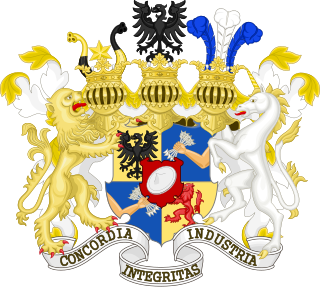
Charles Milles Manson was an American criminal, cult leader and musician who led the Manson Family, a cult based in California, in the late 1960s. Some of the members committed a series of at least nine murders at four locations in July and August 1969. In 1971, Manson was convicted of first-degree murder and conspiracy to commit murder for the deaths of seven people, including the film actress Sharon Tate. The prosecution contended that, while Manson never directly ordered the murders, his ideology constituted an overt act of conspiracy.

The Rothschild family is a wealthy Ashkenazi Jewish noble banking family originally from Frankfurt that rose to prominence with Mayer Amschel Rothschild (1744–1812), a court factor to the German Landgraves of Hesse-Kassel in the Free City of Frankfurt, Holy Roman Empire, who established his banking business in the 1760s. Unlike most previous court factors, Rothschild managed to bequeath his wealth and established an international banking family through his five sons, who established businesses in Paris, Frankfurt, London, Vienna, and Naples. The family was elevated to noble rank in the Holy Roman Empire and the United Kingdom. The family's documented history starts in 16th century Frankfurt; its name is derived from the family house, Rothschild, built by Isaak Elchanan Bacharach in Frankfurt in 1567.

The Manson Family was a commune, gang, and cult led by criminal Charles Manson that was active in California in the late 1960s and early 1970s. The group at its peak consisted of approximately 100 followers, who lived an unconventional lifestyle, frequently using psychoactive drugs, including amphetamine and hallucinogens such as LSD. Most were young women from middle-class backgrounds, many of whom were attracted by hippie culture and communal living and then radicalized by Manson's teachings. The group murdered at least nine people, though they may have killed as many as 24.

Neopseustidae is a small family of day and night-flying "archaic bell moths" in the order Lepidoptera. They are classified into their own superfamily Neopseustoidea and infraorder Neopseustina. Four genera are known. These primitive moths are restricted to South America and Southeast Asia. Their biology is unknown.
Acanthopteroctetidae is a small family of primitive moths with two described genera, Acanthopteroctetes and Catapterix, and a total of seven described species. They are known as the archaic sun moths.
Nematocentropus is a genus of moths in the family Neopseustidae.

The insect order Lepidoptera consists of moths, most of which are night-flying, and a derived group, mainly day-flying, called butterflies. Within Lepidoptera as a whole, the groups listed below before Glossata contain a few basal families accounting for less than 200 species; the bulk of Lepidoptera are in the Glossata. Similarly, within the Glossata, there are a few basal groups listed first, with the bulk of species in the Heteroneura. Basal groups within Heteroneura cannot be defined with as much confidence, as there are still some disputes concerning the proper relations among these groups. At the family level, however, most groups are well defined, and the families are commonly used by hobbyists and scientists alike.

Neopseustis is a genus of moths in the family Neopseustidae.
Synempora is a genus of moths in the family Neopseustidae.
Nematocentropus schmidi is a species of moth belonging to the family Neopseustidae. It was described by Akira Mutuura in 1971. It is known only from the type-locality located southwest of the town of Rupa near the border of Bhutan in Assam, India.
Neopseustis bicornuta is a species of moth belonging to the family Neopseustidae. It was described by D.R. Davis in 1975. It is known from the type-locality, Mount Omei, located in the south-western area of Sichuan Province, China as well as Mount Gong Gashan, also in Sichuan.
Neopseustis archiphenax is a species of moth belonging to the family Neopseustidae. It was described by Edward Meyrick in 1928. It is known from upper Burma and the Sichuan Province in China.

Neopseustis meyricki is a species of moth belonging to the family Neopseustidae. It was described by Hering in 1925. It is known from the central highlands of Taiwan, where it occurs rather widely at elevations exceeding 1,000 meters.
Neopseustis sinensis is a species of moth belonging to the family Neopseustidae. It was described by D.R. Davis in 1975. It is known from the Sichuan Province in south-western China.
Apoplania chilensis is a species of moth belonging to the family Neopseustidae. It was described by D.R. Davis in 1975. It is known from heavily forested areas of central Chile at elevations of 600 to 1,000 meters.
Apoplania penai is a species of moth belonging to the family Neopseustidae. It was described by Davis and Nielsen in 1980. It is known from Argentina, south to Esquel and Chile, south to Chiloé Island.
Nematocentropus omeiensis is a species of moth belonging to the family Neopseustidae. It was described by Hwang in 1965. It is known from Mount Omei in the Sichuan Province of China.
Neopseustis fanjingshana is a species of moth belonging to the family Neopseustidae. It was described by Yang in 1988. It is known from the Guizhou Province and Hunan Province in China.
Apoplania valdiviana is a species of moth belonging to the family Neopseustidae. It was described by Davis and Nielsen in 1985. It is known from the south-western part of the Neuquen Province of Argentina and the eastern part of the Osorno Province and the Cautin Province in Chile.
Aenigmatineidae is a family of basal Lepidoptera, moths discovered on Kangaroo Island in South Australia by Dr Richard Glatz. The family is based on a single species discovered in 2015, Aenigmatinea glatzella, commonly known as the enigma moth. The larvae feed on conifers by mining the stem of Callitris plants in the cypress family. The adult has highly reduced mouthparts but its position in the Glossata containing the more familiar moths-with-tongues is confirmed by morphological and DNA sequence similarity. The group is best treated as a sister of the family Neopseustidae.





